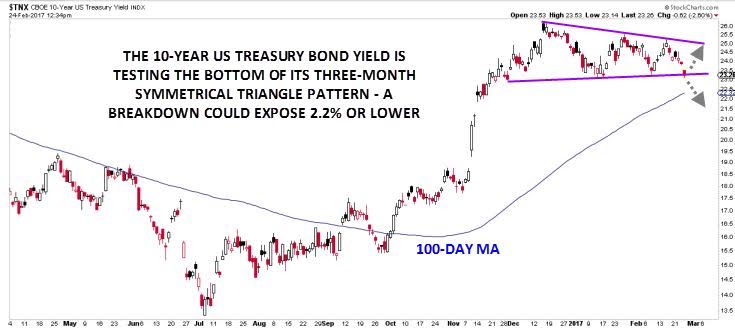For most markets, it's been a bit of an uneventful end to the week: the Dow Jones Industrial Average is trading marginally lower, on track to break its 10-day streak of consecutive rallies, while the dollar is seeing middle-of-the-road performance.
The one market that is on the move today is arguably the most important market of all: the US Treasury market. There's an old trading axiom that the bond market attracts the "smartest" traders, so it's always worth monitoring closely. Based on what we're seeing in the benchmark 10-year bond yield, bond traders are showing signs of shifting into a more defensive posture:
Source: Stockcharts.com
As the chart above shows, the 10-year yield (which moves inversely to the bond's price) has fallen relatively sharply today. Indeed, rates are currently testing the bottom of the big 3-month "symmetrical triangle" pattern. For the uninitiated, these types of patterns are often compared to a coiled spring: as the range continues to contract, energy builds up within the spring. When one of the pressure points is eventually removed, the spring will explode in that direction. Of course, the ultimate direction of these breakouts is notoriously hard to predict, even with yields pressing against the bottom of the triangle pattern.
That said, there's an obvious upcoming fundamental catalyst for a potential breakout early next week: President Donald Trump's address to the joint session on Congress. Traders are optimistic that the new President will flesh out more details to his economic plan, including an update on "phenomenal" proposed tax reform and the status of the promised "massive" infrastructure bill.
Rather than trying to predict the words of a self-proclaimed chaotic world leader, we prefer to follow price. If Tuesday's speech leads to a bearish breakdown from the symmetrical triangle in 10-year yields, odds would favor a continued decline. This could benefit stocks in higher-yielding sectors like Utilities, REITs, Healthcare, and Consumer Staples, as well as hurt the US dollar. On the other hand, a Trump-driven bounce from the bottom of the 10-year yield's symmetrical triangle pattern would signal risk is back "on," likely benefiting cyclical stocks in the Technology, Material, and Energy sectors, as well as providing a tailwind for the US dollar.
Regardless of what happens on Tuesday, investors should constantly keep intermarket relationships and trends in mind!
Thanks,
Matt
This research is for informational purposes and should not be construed as personal advice. Trading any financial market involves risk. Trading on leverage involves risk of losses greater than deposits.
Recommended Content
Editors’ Picks
EUR/USD holds below 1.0750 ahead of key US data

EUR/USD trades in a tight range below 1.0750 in the European session on Friday. The US Dollar struggles to gather strength ahead of key PCE Price Index data, the Fed's preferred gauge of inflation, and helps the pair hold its ground.
GBP/USD consolidates above 1.2500, eyes on US PCE data

GBP/USD fluctuates at around 1.2500 in the European session on Friday following the three-day rebound. The PCE inflation data for March will be watched closely by market participants later in the day.
Gold clings to modest daily gains at around $2,350

Gold stays in positive territory at around $2,350 after closing in positive territory on Thursday. The benchmark 10-year US Treasury bond yield edges lower ahead of US PCE Price Index data, allowing XAU/USD to stretch higher.
Bitcoin Weekly Forecast: BTC’s next breakout could propel it to $80,000 Premium

Bitcoin’s recent price consolidation could be nearing its end as technical indicators and on-chain metrics suggest a potential upward breakout. However, this move would not be straightforward and could punish impatient investors.
US core PCE inflation set to signal firm price pressures as markets delay Federal Reserve rate cut bets

The core PCE Price Index, which excludes volatile food and energy prices, is seen as the more influential measure of inflation in terms of Fed positioning. The index is forecast to rise 0.3% on a monthly basis in March, matching February’s increase.
